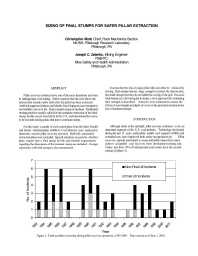Mining Publication: Sizing of Final Stumps for Safer Pillar Extraction
Original creation date: August 2001
Pillar recovery continues to be one of the more hazardous activities in underground coal mining. Safety requires that the roof above the intersection remain stable until after the pillar has been extracted. Artificial supports (timbers and Mobile Roof Supports) are essential to roof stability, but so is the final remnant stump or pushout. Traditional mining practices usually called for the complete extraction of the final stump, but the recent trend (both in the U.S. and internationally) seems to be towards mining plans that leave a remnant stump. For this study, a sample of roof control plans from the Mine Health and Safety Administration (MSHA) Coal Districts were analyzed to determine current pillar recovery practices. Both full- and partial-extraction plans were included. Special attention was paid to whether plans require that a final sump be left, and whether requirements regarding the dimensions of the remnant sump are included. Foreign experience with final stumps is also summarized. It seems that the risk of major pillar falls can often be reduced by leaving final stumps that are large enough to protect the intersection, but small enough that they do not inhibit the caving of the gob. Because final stumps are often irregular in shape, a new approach for estimating their strength is described. Analyses were conducted to assess the effect of seam height and depth of cover on the potential variation in the size of remnant stumps.
Authors: C Mark, JC Zelanko
Conference Paper - August 2001
NIOSHTIC2 Number: 20021383
In: Peng SS, Mark C, Khair AW, eds. Proceedings of the 20th International Conference on Ground Control in Mining. Morgantown, WV: West Virginia University, 2001 Aug; :59-66
See Also
- Coal Bumps and Odd Dynamic Phenomena - A Numerical Investigation
- Evaluation of Pillar Recovery in Southern West Virginia
- Investigation of Pillar-Roof Contact Failure in Northern Appalachian Stone Mine Workings
- Multiple Seam Mining Interactions: Case Histories from the Harris No. 1 Mine
- Multiple-Seam Mining Interactions: Case Histories from the Harris No. 1 Mine
- Observations and Evaluation of Floor Benching Effects on Pillar Stability in U.S. Limestone Mines
- An Overview of Geomechanics Safety Research on Mobile Roof Supports
- Pillar Design and Strategies for Retreat Mining
- Reducing the Risk of Ground Falls During Pillar Recovery
- Stability Analysis of a Backfilled Room-and-Pillar Mine
- Page last reviewed: 9/21/2012
- Page last updated: 9/21/2012
- Content source: National Institute for Occupational Safety and Health, Mining Program


 ShareCompartir
ShareCompartir
